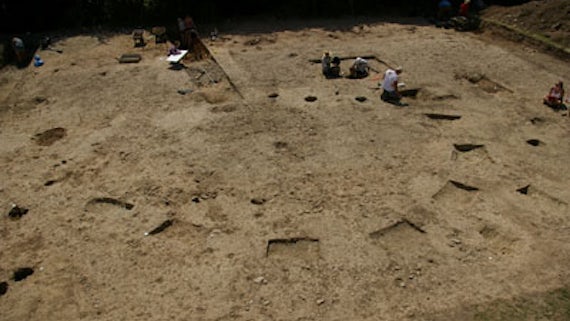Revealing Cardiff's hidden powerhouse
24 Gorffennaf 2013

Excavations to the West of Cardiff are revealing that two and a half thousand years ago, in the Iron Age, Caerau hillfort was the political and power centre for the entire Cardiff region.
Dr Oliver Davis, Co-Director of the CAER Heritage Project from the University's School of History, Archaeology and Religion explains the starting point of the project: "Despite its size and obvious importance the site is a bit of an enigma. No archaeologists have ever explored the hillfort and as a result nobody knows how the settlement was organised inside, how long it was occupied, or even who lived there."
The initial dig this summer has uncovered a considerable amount of new information, including three Iron Age roundhouses and a stone-built pathway that runs around the edge of the hillfort.
"Our community excavations show that occupation at the site continued until at least the third century AD, well into the Roman period. Domestic life is indicated by the discovery of simple tools and ceramics from all periods and a glimpse of the personality of the inhabitants is provided by the discovery of a glass bead of Iron Age date and an enamelled disc brooch of Roman date. Both these objects indicate that individuals were concerned with their appearance and that life in the past was a little more colourful that we sometimes think," added Dr Davis.
Over the past month [24 June - 19 July 2013] the team has also examined the inner of the three ramparts that surround the hillfort. These ramparts and their associated ditches were unlikely to have been built just for defence.
"People think of these sites as defensive structures, but our attention is turning to whether the people who lived there were actually developing a community or collective identity for themselves," said Dr Davis.

The Caerau and Ely Rediscovering (CAER) Heritage Project - a collaborative project between Cardiff University, Action in Caerau & Ely (ACE), local schools and local residents - is about far more than its archaeological discoveries. The community - people of all ages and backgrounds – has driven the project. Three local high schools have participated with pupils digging and undertaking a range of activities on site. Local youth centre Pethyrbridge North Ely has also visited with young people facing exclusion. Throughout the month of the dig, numerous local residents and visitors from far and wide have taken tours of the site.
At key milestones, the community has come together to celebrate the project. At the project's Iron Age Hog Roast at the hillfort, 200 community members and Cardiff residents came together to see the latest finds. 130 visitors discovered more about the CAER project at the Ely Festival. As part of the project at National Museum Wales, St Fagans, around 150 visitors have seen archaeological wet sieving activities in action, revealing more from the finds of the excavation.
At the Ely Festival Welsh Minister for Health & Social Services Mark Drakeford launched the heritage trail project linking this ancient site with the National Museum at St Fagans, bringing the past and the future together and physically linking two sites of significance for the heritage of South Wales. The Minister, local councillors and Assembly Member for South Wales Central Eluned Parrott have also visited the excavation.
Dave Horton, Community Development Coordinator of Action in Caerau & Ely, has seen a new found pride in the community throughout the project: "The last few weeks have seen a whirlwind of activity in Ely and Caerau focused around our beautiful iron-age hillfort. Literally hundreds of local people have visited the site and have dug together, learned new skills, shared local knowledge, and have celebrated together with a fantastic iron-age hog roast! We have all walked down the hill to our homes with a different perspective. We have found new pride in the history of our community, and have been inspired to continue building community for the future."
Co-director of the project Dr Dave Wyatt of the School of History, Archaeology and Religion adds: "Excavations bring diverse people together with a shared purpose of discovery. They give people new skills and confidence and by physically exploring the past they foster a new way of looking at the world around us, giving new perspectives. They create new and often unlikely friendships which can sometimes last a lifetime."
Read more about the CAER Heritage Project and future plans on their blog: http://caerheritageproject.com/